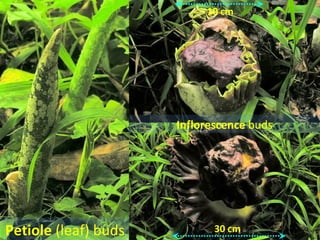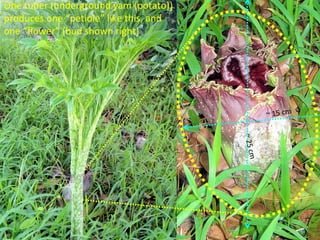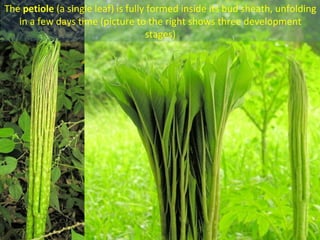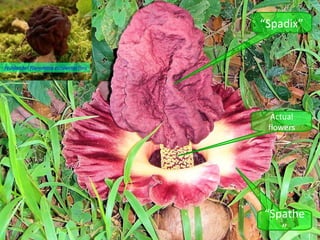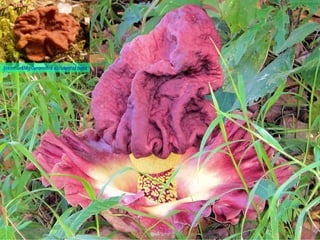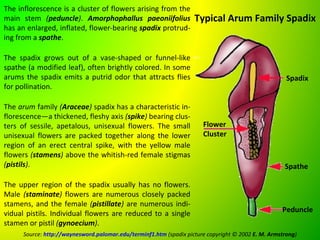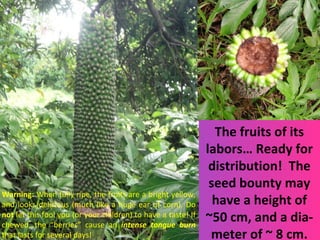Amorphophallus paeoniifolius
- 1. Amorphophallus (from Ancient Greek amorphos, "without form, misshapen" + phallos, "penis," referring to the shape of the prominent spadix) is a large genus of some 200 tropical/subtropical tuberous herbaceous plants from the Arum family (Araceae). A few species are edible as "famine foods" after careful preparation to remove irritating chemicals. These typical lowland plants grow in tropical/subtropical zones of the paleotropics, from West Africa to Pacific islands. Most species are endemic, and prefer disturbed grounds, such as secondary forests. These small to massive plants grow from a sub- terranean tuber that varies between species, from the quite uniformally globose tuber of A. konjac, to the elongated tubers of A. longituberosus and A. macrorhizus, to the clustered rootstock of A. coaetaneus. From the tuber grows a trunk-like petiole (a single leaf)—which can be several meter across in larger species—a vertical stalk with a horizontal blade and a number of small leaflets, which lasts one growing season. The tuber also shoots out a single inflorescence, with a peduncle (primary flower stalk) that can be long or short. Typical of the Arum family, the inflorescence has an elongate or ovate spathe (a sheathing bract) which usually envelops the spadix (a flower spike with a fleshy axis). The spathe can have different colors, but mostly brownish-purple or whitish- green. Inside, they contain ridges or warts, functioning as insect traps. Source: http://en.wikipedia.org/wiki/Amorphophallus
- 2. Amorphophallus paeoniifolius (Formlös fallos, (English: Malformed Male Member…)) ~ 50 cm (20”) ~ 50 cm (20”)
- 3. 10 cm Inflorescence buds Petiole (leaf) buds 30 cm
- 4. One tuber (underground yam (potato)) produces one “petiole” like this, and one “flower” (bud shown right) ~ 15 cm ~ 25 c m
- 5. The petiole (a single leaf) is fully formed inside its bud sheath, unfolding in a few days time (picture to the right shows three development stages)
- 6. ~ 50 cm (20”) The “hat” has an uncanny likeness to the false morel mushroom: Also known as Pongapong, Big Stinky, Elephant foot yam, Whitespot giant arum, Stink lily, Jimmikand, Corpse flower, Voodoo lily, and many more… False Morel (Gyromitra esculenta) (Im
- 7. The petiole shows a beautiful symmetry in how the rachi and its leaflets unfold (Right: after ~ two days; Left: after ~ five days)
- 8. “Spadix” Frühlorchel (Gyromitra esculenta) (Image courtesy Wikipedia DE) Actual flowers “Spathe ”
- 9. The Petiole: Not a stem with leaves! “Leaflet” “Leaflet” “Rachi” The large Amorphophallus tuber , grown for food, may weigh anywhere from 3 to 25 kg “Petiole” The petiole is actually a single divided leaf, the “stem proper” is the underground tuber (yam). When flowering, the flower bud and petiole shoots up simultaneously, in only a few days. Here in Tagaytay, the petiole (now containing most of the carbohydrates previously stored in the tuber) is harvested and cooked as a vegetable. Elephant Yam tuber (konnyaka potato ) (Imag
- 10. Stenmurkla (Gyromitra esculenta) (Image courtesy Sofia Bryntse)
- 11. The inflorescence is a cluster of flowers arising from the main stem (peduncle). Amorphophallus paeoniifolius Typical Arum Family Spadix has an enlarged, inflated, flower-bearing spadix protrud- ing from a spathe. The spadix grows out of a vase-shaped or funnel-like spathe (a modified leaf), often brightly colored. In some arums the spadix emits a putrid odor that attracts flies Spadix for pollination. The arum family (Araceae) spadix has a characteristic in- florescence—a thickened, fleshy axis (spike) bearing clus- ters of sessile, apetalous, unisexual flowers. The small Flower unisexual flowers are packed together along the lower Cluster region of an erect central spike, with the yellow male flowers (stamens) above the whitish-red female stigmas (pistils). Spathe The upper region of the spadix usually has no flowers. Male (staminate) flowers are numerous closely packed stamens, and the female (pistillate) are numerous indi- vidual pistils. Individual flowers are reduced to a single Peduncle stamen or pistil (gynoecium). Source: http://waynesword.palomar.edu/terminf1.htm (spadix picture copyright © 2002 E. M. Armstrong)
- 12. Male flowers: many, small Pungent pheromones (smells like putrefying meat) attract pollinators (flies, beetles) Female flowers: fewer, bigger
- 13. The fruits of its labors… Ready for distribution! The seed bounty may Warning: When fully ripe, the fruits are a bright yellow, and looks delicious (much like a huge ear of corn). Do have a height of not let this fool you (or your children) to have a taste! If chewed, the “berries” cause an intense tongue burn ~50 cm, and a dia- that lasts for several days! meter of ~ 8 cm.
- 14. Easy to see what earned it the name “Malformed Male Member”… Amorphophallus paeoniifolius www image samples (images hyperlinked to source web site)
- 15. Henry Norman MicroTech Consulting Tagaytay City Philippine Islands Googleplus/Henry.KO.Norman Copyright © 2012 Henry Norman



